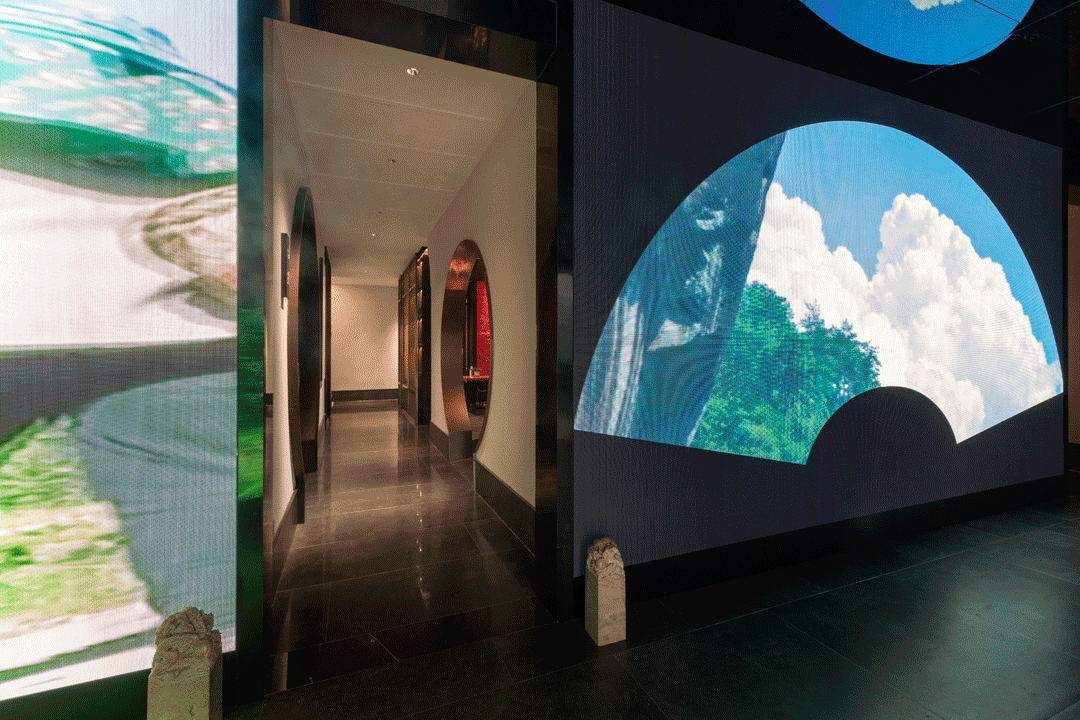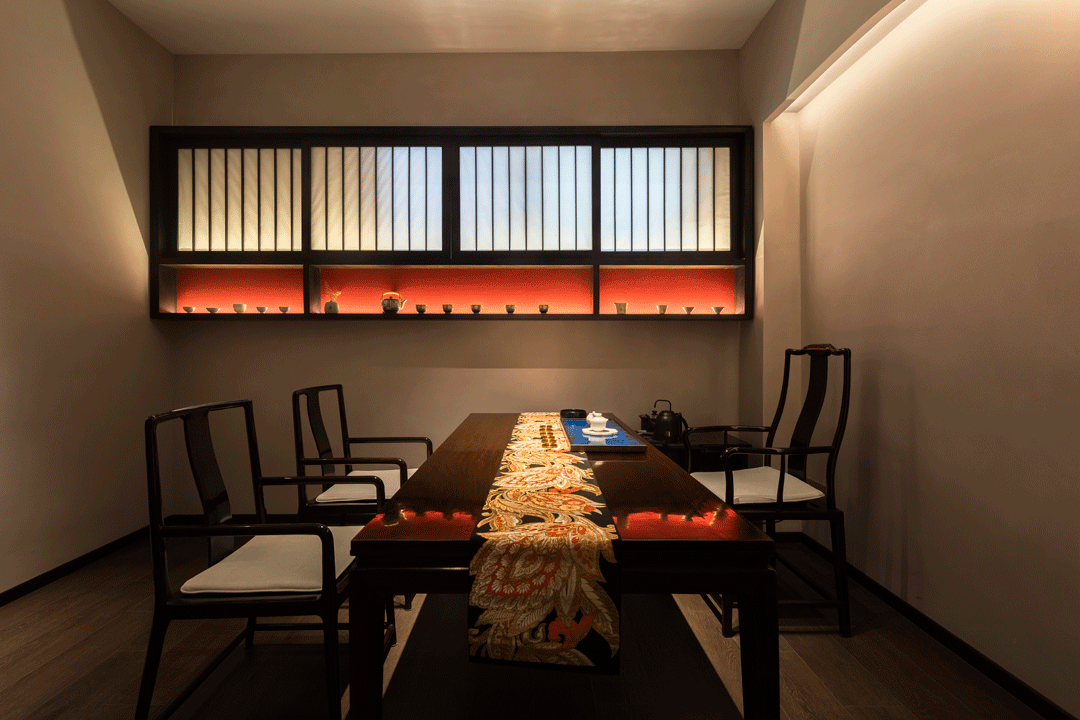查看完整案例


收藏

下载
记忆中的茶空间,是连空气中都散发着禅意的气息,而此空间的设计师在传统茶寮空间上进行了当代艺术形式的不断尝试突破。借用马歇尔·麦克卢汉的话来表述:“艺术是你可以逃脱的任何东西。”设计师利用岩上得天独厚的空间资源,借用传统回廊式空间格局,在公共空间与人文、与沉浸式科技、与昆曲、与环境的关系上进行深度探索,将传统空间、漆艺及当代装置,与艺术作品做跨界结合,是一次在特定语境下的当代化表现。
The tea space in the memory, even the air exudes the breath of Zen, and the designers of this space have made continuous attempts and breakthroughs in contemporary art forms in the traditional tea room space. To borrow the words of Marshall McLuhan: "Art is anything you can escape from." The designer uses the unique space resources of the rock, borrows the traditional corridor-style space pattern, in the public space and humanities, and immersive technology, and Kunqu Opera, In-depth exploration of the relationship with the environment, combining traditional spaces, lacquer art, and contemporary installations with art works, is a contemporary expression in a specific context.
整个空间是将当代艺术与传统文化相结合,探讨人与空间、与自然的一种关系,也是传统文化当代性的综合实验呈现。在这里,茶文化作为媒介将每一要素有机地关联起来。不管是过去还是现在,设计师用当代的语境来表达传统的思维,在入口处利用金属的质感来呈现传统竹帘式线型隔断,并在门面的中间位置,借用了悬浮挂巨石的装置艺术,在沉浸式蓝色炫光中,诉求的是一种原始的状态,构建出纯粹的精神世界。
The entire space is a combination of contemporary art and traditional culture, exploring a relationship between man and space, and nature. It is also a comprehensive experimental presentation of the contemporaryity of traditional culture. Here, tea culture is used as a medium to organically connect each element. Whether it is the past or the present, the designer expresses traditional thinking in a contemporary context, using metal texture at the entrance to present traditional bamboo curtain linear partitions, and in the middle of the facade, borrowing the device of floating huge boulders Art, in the immersive blue glare, appeals to a primitive state, constructing a pure spiritual world.
从悬浮巨石边的大门进入茶室内,映入眼帘的是远处的不锈钢“一览众山小”的装置。它以一种“引序”的方式,开启了此次“游园惊梦”的茶室篇章。其实,设计师的诉求是:茶空间是一种生活路径,可以通过探索的方式帮助人们找寻一种与传统对谈的方式,让“当下”变得自然、诗意、舒适。
Entering the tea room from the gate beside the floating boulder, what you see is the stainless steel device in the distance that "sees the mountains and small mountains". It opened the tea room chapter of the "dream in the garden" in a kind of "introduction" method. In fact, the designer’s appeal is: tea space is a way of life, which can help people find a way to talk with tradition through exploration, so that the "present" becomes natural, poetic and comfortable.
迂回的回廊之后,设计师为了精心设计出一个“动态的、可变的”茶空间。这是设计师的巧心思,除了设计出室内四合院要素之外,还精心录制了武夷山视频,以多媒体技术手段与游园惊梦的昆曲碰撞与冲击中,让灯光艺术与传统艺术打破空间高度和封闭关系的不同区分和限定,在空间和特定行为方式里有效地融为一体。好比扇面的多媒体视觉数码艺术,就是通过构筑人与光、空间与人文的玩耍与节点,能够让人与构筑物形成互动,让人停留与驻足。
After the roundabout corridor, the designer carefully designed a "dynamic and variable" tea space. This is the designer’s ingenuity. In addition to designing the elements of the indoor courtyard, the video of Wuyi Mountain was carefully recorded, and the collision and impact of the Kunqu opera with the surprise of the garden with multimedia technology, let the lighting art and traditional art break the height and closure of the space, and the different distinctions and limitations of relationships are effectively integrated in space and specific behaviors. Multimedia visual digital art, like a fan, is through the construction of play and nodes between people and light, space and humanity, allowing people to interact with structures, allowing people to stay and stop.
在曲径通幽的尽头,在四合院式的圆拱门之间,设计师通过在沉浸式天顶下、通道拱桥上吟唱昆曲的游园惊梦,完美再现了中国四合院式的体验式生活。此种行为艺术式的表现手法,传达的是为繁忙的都市人提供一处片刻安宁的“心灵庇护所”。这里是整个茶室对外的窗口,更是设计师与艺术家共同综合性实验的场所。在这里,他们利用一个当代与传统的艺术语境下的精神诉求模式,设计出结构与行为的关联关系,最终追求的不过是一器一皿、一桌一凳,一盏茶、三好友,促膝而谈、相聊甚欢。
At the end of the winding path, between the courtyard-style round arches, the designer perfectly reproduces the experiential life of the Chinese courtyard-style courtyard by singing the dream of Kunqu opera under the immersive zenith and on the passage arch bridge. This kind of performance art-style expressing technique conveys a "spiritual sanctuary" for busy urbanites to provide a moment of tranquility. This is the window to the outside of the entire tea room, and it is also a place for designers and artists to conduct comprehensive experiments. Here, they use a spiritual appeal model in the context of contemporary and traditional art to design the relationship between structure and behavior. The ultimate pursuit is only one vessel, one table, one stool, one cup of tea, and three friends. Talk and chat very happily.
正大厅的品茗区,有一抹红让人眼前一亮,那就是中庭处亦可见的红色木雕漆画。它表述出的是传统的宋代界面,记录着过去喝茶发展的运行轨迹,仿佛跨越了漫漫历史长河,让你穿越至古代感受文人的茶生活体验。
从某种意义上来说,岩上作为现代茶文化生活方式的倡导者,与设计师沟通后,试图与艺术家们进行创新与突破。他们带着一种质疑、探究、发现的态度,和对现实世界的挑战,在当代艺术的美学语境中催生出新的灵感,以人文的积淀、艺术的渗透,探寻茶空间的另一种体验。
In the tasting area of the main hall, there is a touch of red that makes people’s eyes bright, that is, the red woodcarving lacquer paintings that can also be seen in the atrium. It expresses the traditional Song Dynasty interface, recording the track of the development of tea drinking in the past, as if crossing the long river of history, allowing you to travel to the ancient times to experience the tea life experience of the literati. In a sense, as an advocate of modern tea culture and lifestyle, Iwashang tried to innovate and break through with artists after communicating with designers. With an attitude of questioning, inquiry, discovery, and challenges to the real world, they have spawned new inspirations in the aesthetic context of contemporary art, and explored another kind of tea space with the accumulation of humanities and the penetration of art. Experience.
值得一提的是四合院两边对称的茶室包厢,却有“执古之道,以御今之有”的沉浸体验。在这个有限的空间里,中西交汇,古今纵横,以有观无,以小观大。观之茶室中的细节就可窥见一二,黑檀红木家具展现出悠悠古韵浓的气息;大漆桌与“卧石读茗、叠变...”漆艺包厢门牌,都出自漆艺术家精心制作,传统蓝色大漆为底,文字以堆漆的方式呈现,理想的人生景致,探讨传统文化与当代艺术的关系。设计师所要表达的是,艺术性的审美格局并非过度关注形式,应该更多的关注本来的自我。
It is worth mentioning that the symmetrical tea room boxes on both sides of the courtyard have an immersive experience of "holding the ancient ways to protect the present." In this limited space, China and the West meet, the ancient and modern are vertical and horizontal, with the view that there is nothing and the view is big. You can see the details in the tea room of Guanzhi. The ebony mahogany furniture shows a long and long atmosphere; the large lacquer table and "Looking on the stone, reading the tea, repetition..." lacquer art box number, carefully crafted by the lacquer artist, The traditional blue lacquer is the base, the text is presented in the form of piled lacquer, the ideal life scene, explore the relationship between traditional culture and contemporary art. What the designer wants to express is that the artistic aesthetic pattern is not to pay too much attention to the form, but to pay more attention to the original self.
平面图 / Floor plan
设计师 / Designer
洪 斌
—
唐玛国际设计 创始人/设计总监
国家注册室内建筑师
中国建筑学会室内设计分会名誉理事
福建省环境艺术设计协会副会长
CIID 中室学(福州)室内建筑师中心 常务副主任
艺术家 / artist
龙一 Long Yi
—
無論艺术工作室艺术总监
出生于湖南郴州
毕业于福建师范大学美术学院获学士学位
师承汤志义
现工作居住于福建福州
半山空间成立于 2017 年。空间立足于为当代艺术家的日常/思考和艺术实验,建立起一个交流的平台,设立艺术展览/表演/讲座/教育/艺术设计,本着开放/公益/学术化的理念,为梳理和推广当代艺术的多元而贡献绵力。
项目名称丨岩上 空谷幽兰·旗舰店
Project name丨Yanshang Konggu Youlan Flagship Store
项目面积丨300㎡
Project area丨300㎡
设计时间丨2020.7
Design time丨2020.7
完工时间丨2021.1
Completion time丨2021.1
设计事务所丨唐玛·洪斌设计事务所
Design Office丨TOMA Hong Bin Design Office
主案设计丨洪 斌
Main case design丨Hong Bin
艺术家丨龙一(無論 WULEN)黄泽渊(半山空间)
Artist丨Long Yi (whatever WULEN) Huang Zeyuan (mid-mountain space)
设计团队丨兰苹发 连丽玮
Design Team丨Lan Pingfa Lian Liwei
文 案丨胡艳娜
Copywriting丨Hu Yanna
摄 影丨科 比
Photograph丨Kobe
项目位置丨福建福州鼓楼区五四路省体育中心 310 号东 3 门 1 层
Project location丨1st Floor, East Gate 3, No. 310, Provincial Sports Center, Wusi Road, Gulou District, Fuzhou, Fujian
项目主材丨福建开荒科技有限公司(智能与 LED 视频)、福州合境贸易有限公司(新风)、鹰牌瓷砖(水墨京砖)、乐迈防水地板、都饰建材(乐家)、福州金美原木业有限公司、创斯照明、贝莱维斯涂料
























































